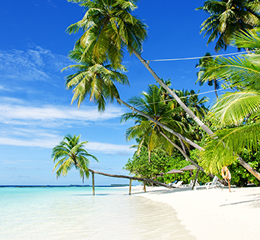Select a region (Please consider current travel restrictions)
United Arab Emirates

Destination overview
The United Arab Emirates is a constitutional federation of seven emirates - Abu Dhabi, Dubai, Sharjah, Ajman, Umm al-Qaiwain, Ras al-Khaimah, and Fujairah. The federation was formally established in December 1971. The United Arab Emirates (UAE) occupies an area of 83,600 square kilometres along the south-eastern tip of the Arabian Peninsula. Qatar lies to the west, Saudi Arabia to the south and west and Oman to the north and east. The capital and the largest city of the federation, Abu Dhabi, is located in the emirate of the same name.
Four-fifths of the UAE is desert, yet it is a country of contrasting landscapes, from magnificent dunes to rich oases, precipitous rocky mountains to fertile plains. The United Arab Emirates, one of the world's fastest growing tourist destinations, has all the right ingredients for an unforgettable holiday of sun, sand, sea, sports, fantastic shopping, top-class restaurants, an intriguing traditional culture and a safe and welcoming environment.
The UAE has 734 kilometres of coastline, 644 kilometres along the Arabian Gulf and 90 kilometres bordering the Gulf of Oman. Along the Arabian Gulf coast are offshore islands, coral reefs and salt marshes, while stretches of gravel plain and barren desert characterise the inland region. The western interior of the federation, most of which is Abu Dhabi territory, consists mainly of desert interspersed with oases. One of the largest oases is Liwa, beyond which is the vast Rub al-Khali desert, or Empty Quarter, which stretches beyond the UAE’s southern border.
Abu Dhabi
Abu Dhabi is one of the most modern cities in the world. It is the centre of government and business life in the UAE, headquarters of the emirates oil operating companies and foreign embassies are based here. Large gardens and parks, green boulevards lining all the streets and roads, sophisticated high-rise buildings, state-of-the-art communication services and transport, rich shopping malls, cultural centres and events provide tourists with a one-of-a-kind experience throughout the year.
Abu Dhabi is the largest of the seven Emirates and the Federal capital of the UAE. Its long coastline - the shallow waters of the Southern Gulf, extending from the base of the Qatar Peninsula in the west to the border of the emirate of Dubai on the north-east, was once the world's best waters for pearling. When the pearling industry declined, oil discovery in the offshore oilfields of the Southern Gulf revived the economy of Abu Dhabi. On the land, it stretches south to the oases of Liwa where some of the world’s largest sand dunes can be found, and east to the ancient oasis of Al Ain. This makes Abu Dhabi the largest as well as the most populated of all the emirates.
The city’s progressive vision is tempered with a deep-seated respect for traditions and culture and tucked away between modern towers are heritage locales that tell tales of Abu Dhabi’s past. Priority has been given not only to future development but to rediscovering the past through archaeology, the restoration of buildings, museums, establishing indigenous wildlife parks and much more.
Especially honoured is the Bedouin way of life. Even though nomadic societies leave little in the way of permanent structures, the people of Abu Dhabi aspire to the noble traditions and values of their desert ancestors.
Dubai
The main sightseeing circuit in Dubai is split between Bur Dubai and Deira which lie on opposite sides of the water and the gently curving Dubai Creek is an attraction in itself. There are brilliant views of the city from the water - gleaming skyscrapers on one side and old trading dhows on the other.
Deira's many attractions include the historic quarter of Bastakia, as well as old souks and covered marketplaces. Wandering along the alleys, you can explore the Spice Souk and the Gold Souk. The Dubai Museum is housed within the beautifully restored Al Fahidi Fort and is a must-see for first time visitors to Dubai. Built in 1799 to defend the city against invasion, it has served as both palace and prison and the museum's collection includes life-size figures and galleries depicting Arab houses, mosques, date gardens, desert and marine life.
On the Bur Dubai side, Heritage Village, located in the Shindagah area is a family destination where you can watch potters, weavers and artisans at their crafts. The adjoining Diving Village offers a cultural microcosm of pearl diving and fishing. Sheikh Saeed Al Maktoum House, a museum restored from the house of Dubai's former ruler and dating back to the late 1800s, is within the same complex. With its unusual layered rooms and authentic wind towers, Sheikh Saeed's House showcases regional architecture at its best.
About 115 kilometres south-east of Dubai, in the heart of the rocky Hatta Mountains, is the 3,000 year old Hatta Village, an important historical site for the region. The two towers overlooking the village were once defence fortresses against hostile invaders.
Dubai is a shopper's paradise, and whatever you’re looking for, you’ll find it here. The city is one of the largest retail gold markets in the world and bargaining is welcomed almost everywhere. The Gold Souk area in Deira has glittering street-front stores and hides dozens of alleys housing smaller shops.
Some of Dubai's beaches are attached to private hotels, where, for a small fee, you can spend the day on the sand and in the waters of the Arabian Gulf. Other beaches and waterfronts - the Corniche and the Creek - are free for public access and feature a range of water sports offered by several operators.
One of Dubai's most popular tourist attractions is the desert safari - a unique experience that combines an adventurous 4WD car ride over sand dunes with camels, belly dancers, henna designers, falconers and a barbecue dinner by starlight. Other attractions include sand skiing, sand boarding and sand karting.
Sharjah
Sharjah is a city of learning and the arts, as confirmed by its 1998 UNESCO designation as the Cultural Capital of the Arab World. Strategically situated between the Far East and the West, Sharjah is a global trade centre. The third largest of the seven states that form the United Arab Emirates, Sharjah probably has the most colourful history of all the Emirates. From the days of the early trading with the East to the settlement of the Qawasim seafaring tribe and into the first half of the 19th century, Sharjah was the most important port on the lower Arabian Gulf.
Sharjah has beautiful beaches on the shores of the Arabian Gulf in the West and the Gulf of Oman and Indian Ocean in the East, and is the only emirate to have land on both the Arabian Sea and the Indian Ocean.
For Western visitors, the UAE is a very safe Middle East destination, with the comforts of home and a taste of the exotic. You can shop, laze on a gorgeous beach and sip a cocktail. Or, you can soak up the atmosphere of the heritage areas, haggle over souvenirs in the souqs, head out to Abu Dhabi's desert sands for a camel ride under a star-filled sky, or dive the coral-filled waters of the Gulf - the beaches near Ras Al-Khaimah are as beautiful as you'll see anywhere in the region. Or simply mix up a blend of everything; after all, that’s what makes the UAE unique.
DAE Resorts in this Destination
Spark your curiosity
with our hand-picked collections
Ready to go more places?
Discover where 7Across members are exploring.
Browse below to see some of the resorts other members have recently booked and spark your curiosity.
- Exchange
- Bonus week
- Rental














